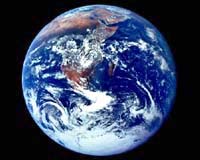
 |
This scenario does not belong in the realm of fantasy, for it happened not once but at least twice between 800 million and 550 million years ago, in extraordinary climate events that have become known as "Snowball Earth".
How these brutally protracted Ice Ages unfolded have always been a puzzle.
Some speculate that the Sun abruptly cooled for a while or that the Earth tilted on its axis or experienced an orbital blip that dramatically reduced solar warmth.
But a new study by French scientists throws light on a little-explored theory -- how tectonic wrenches that ripped apart the Earth's land surface provoked a runaway "icehouse" effect.
At the time, all the Earth's future continents were glommed together in a super-continent dubbed Rodinia, an entity so vast that rainfall, brought by winds from the oceans, failed to travel far inland.
When Rodinia pulled apart, breaking up into smaller pieces that eventually formed today's continents, rainfall patterns changed dramatically.
Rain tumbled over basalt rocks, freshly spewed from vast volcanic eruptions.
That initiated a well-known reaction between the water and calcium silicate, in which carbon dioxide (CO2) molecules are taken from the air and sequestered in calcium carbonate, which is then washed down to the seas.
CO2 is the famous "greenhouse" gas -- it hangs like an invisible blanket in the atmosphere, and prevents the Sun's heat from bouncing back into space. Instead, this heat is stored up in the seas and land masses.
At present CO2, disgorged by the burning of fossil fuels, is being blamed for the looming threat of global warming.
But a computer model published on Thursday postulates that the reverse happened hundreds of millions of years ago.
The weathering of silicate rocks sucked CO2 out of the air, thus leading to a catastrophic cooling.
According to the simulation, before Rodinia broke up around 800 million years ago, C02 concentrations were around 1,830 parts per million (ppm); the mean global temperature was 10.8 C (51.5 F); and regions of the Earth that were below freezing point extended down to around 60 degrees in both hemispheres.
Fast-forward to Rodinia's breakup, 50 million years later, and the picture is greatly different.
CO2 levels are at 510 ppm; the planet's mean temperature is a frigid two C (35.5 F); and freezing temperatures have migrated towards the mid-latitudes, of 40-45 degrees.
"Tectonic changes could have triggered a progressive transition from a 'greenhouse' to an 'icehouse' climate during the neo-Proterozoic Era," the authors say.
Combine this with the rock/rainfall reaction, and the simulation "results in a snowball glaciation."
Lead author of the study, published on Thursday in the British weekly journal Nature, is Yannick Donnadieu of the CNRS' Laboratory for Climate and Environment Sciences at Gif sur Yvette, south of Paris.
Accelerating the movement towards an Ice Age is a phenomenon called albedo.
When more of the planet is covered with ice and snow, the temperature falls faster, because white surfaces reflect the Sun's rays rather than capture them.
Eventually, the albedo cycle would go into reverse, thanks to volcanic eruptions which would disgorge billions of tonnes of CO2, causing atmospheric temperatures to rise once more.
TERRA.WIRE |